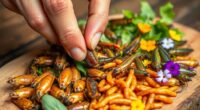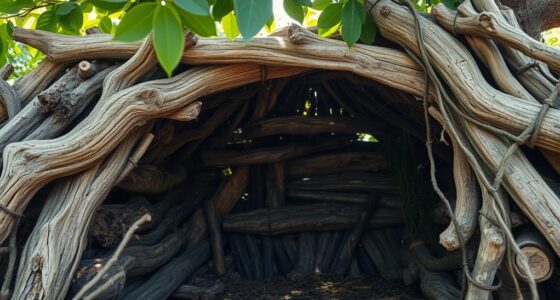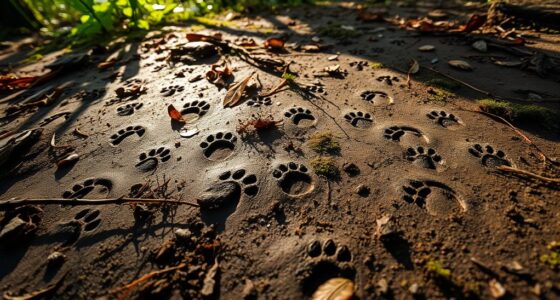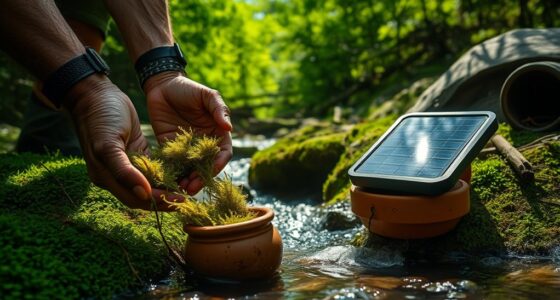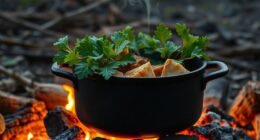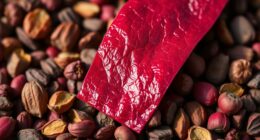To build a 72-hour wilderness forager’s cache, start by evaluating your environment for safe, edible plants and fungi using field guides and key features like leaf shape and growth patterns. Select a variety of nutrient-rich foods such as berries, roots, and fungi, then preserve them through drying or freezing. Use airtight containers and keep supplies in cool, dark places. Proper planning, seasonal awareness, and safe foraging techniques are essential—stay tuned to discover more detailed tips to maximize your survival plan.
Key Takeaways
- Select a diverse mix of edible wild plants, fungi, berries, and nutrient-dense foods to ensure a balanced, energy-rich 72-hour cache.
- Use airtight, lightweight containers and preservation methods like drying or freezing to maintain food quality over time.
- Incorporate gear such as knives, fire starters, and safety tools for efficient foraging and emergency preparedness.
- Follow ethical foraging practices by harvesting sustainably, only collecting identified safe species, and respecting seasonal and environmental considerations.
- Regularly inspect, rotate, and replenish your cache to ensure freshness, safety, and adaptability to seasonal wild food availability.
Assessing Your Wilderness Environment and Identifying Edible Plants
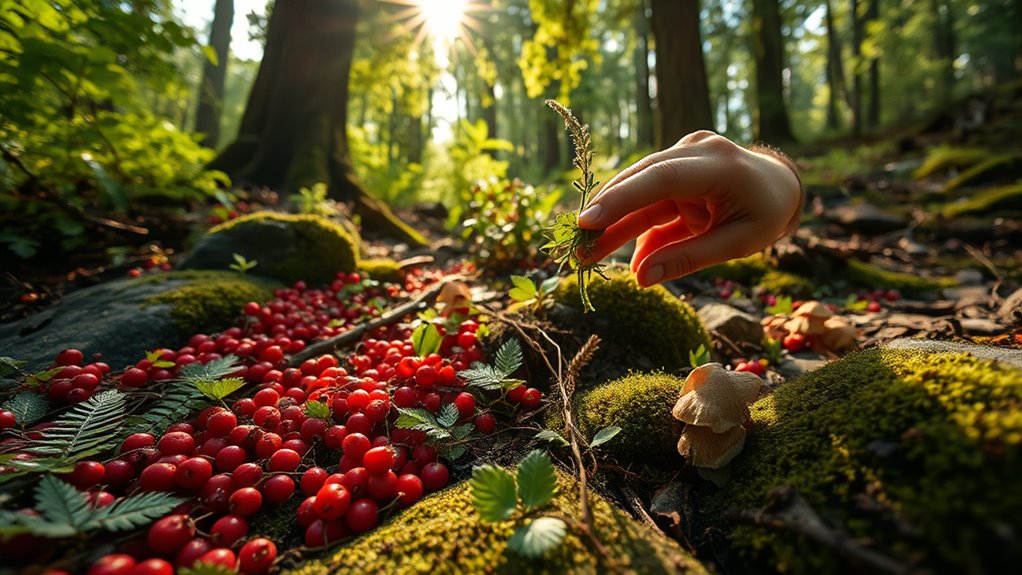
When venturing into the wilderness, understanding how to assess your environment is essential for locating edible plants. Start by observing your surroundings carefully—note the types of plants, trees, and fungi present. Wildflower identification helps you recognize safe, nutritious edible flowers and plants, while avoiding toxic look-alikes. Pay attention to the season, as many edible fungi grow only in specific conditions; learn to identify edible fungi like chanterelles or porcini, but also be cautious of poisonous varieties. Examine plant features such as leaf shape, color, and growth pattern to determine if they’re safe to consume. Remember, accurate wildflower identification and fungi recognition are critical skills. Developing these skills ensures you can forage confidently and safely while exploring the wilderness. Proper identification techniques are vital to avoid accidental ingestion of toxic species and ensure a successful foraging experience.
Selecting Essential Items for Your Forager’s Cache

When choosing items for your forager’s cache, focus on maintaining a balanced diet that keeps you energized and healthy. Prioritize lightweight, compact supplies that won’t weigh you down during travel. Don’t forget to include self-defense tools to protect yourself in unexpected situations. Being aware of trust issues can help you better assess the safety and reliability of your supplies and environment.
Nutritional Balance Priorities
How do you guarantee your forager’s cache maintains a proper nutritional balance? Focus on ensuring nutritional diversity by including a variety of food groups—proteins, fats, carbs, vitamins, and minerals. This diversity helps prevent deficiencies and keeps your energy levels stable. Prioritize whole foods like nuts, dried fruits, seeds, and lean meats, which provide essential nutrients naturally. To cover gaps, consider lightweight dietary supplements like multivitamins or mineral tablets, especially if certain food items are limited. Balancing your cache with these essentials ensures you get a broad spectrum of nutrients without overloading on any one item. Regularly review your selections to maintain a well-rounded, sustainable nutritional profile, giving you confidence that your cache supports your health during critical times. Incorporating nutritional diversity into your planning helps optimize your overall sustenance.
Lightweight, Compact Items
What are the most essential lightweight, compact items to include in your forager’s cache? Focus on lightweight gear that minimizes bulk without sacrificing functionality. Choose compact containers for storing food and tools, such as small, leak-proof bottles or collapsible pouches. These containers make it easier to organize and access your supplies quickly. Prioritize multi-use items like a compact knife or a lightweight fire starter, which serve multiple purposes while remaining portable. Avoid bulky equipment that adds unnecessary weight. Remember, every ounce counts when you’re relying on your cache for survival. Selecting the right lightweight gear and storage solutions ensures your supplies stay manageable, accessible, and efficient, helping you conserve energy and stay prepared for any situation.
Self-Defense Essentials
Ensuring you have effective self-defense items in your forager’s cache is essential for safety and peace of mind. Whether steering through urban safety challenges or wildlife encounters, being prepared can prevent harm. Focus on compact, reliable tools that are easy to carry. A compact design in your self-defense gear allows for easier concealment and quick access when needed. 1. Pepper spray or bear spray offers quick protection against aggressive wildlife or threats in urban and wilderness settings. 2. A sturdy, multi-purpose folding knife provides both defense and utility. 3. A personal alarm or whistle can attract attention in emergencies, deterring potential threats. These items help you stay alert and protected, whether in urban safety situations or unexpected wildlife encounters. Prioritizing self-defense essentials ensures you’re prepared for any scenario during your foraging expedition.
Understanding Seasonal Variations in Edible Wild Foods
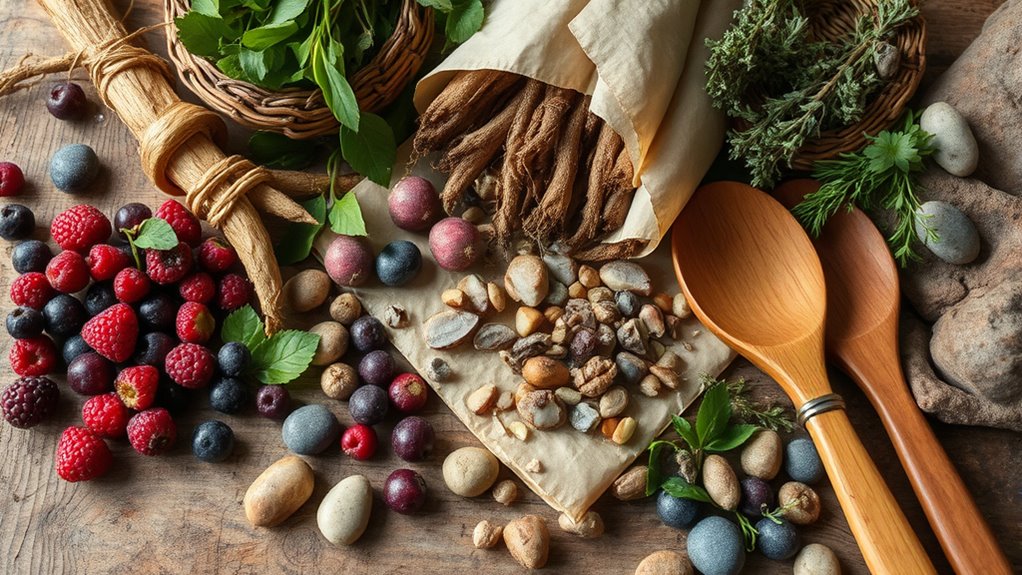
You’ll notice that wild foods become available at different times of the year, affecting what you can harvest. Preserving your finds guarantees you have supplies during off-seasons, making timing essential. Using a foraging calendar helps you plan your collection and manage seasonal shifts effectively. Incorporating seasonal availability into your foraging strategy ensures a more reliable food security plan year-round.
Seasonal Availability Changes
Have you ever noticed how the availability of wild foods shifts throughout the year? Seasonal changes dramatically influence what you can harvest from wildlife habitats. For example, certain edible fungi flourish in fall, while early spring offers fresh greens. Understanding these patterns helps you plan your foraging effectively.
Consider these factors:
- Climate and temperature affect when edible fungi fruit, often peak in moist, cool conditions.
- Plant life cycles dictate the timing of berries and greens, with many appearing in late spring and summer.
- Wildlife activity influences the abundance of insects and game, which can impact the ecosystem’s plant growth and fungi development. Recognizing these variations guarantees you maximize your foraging during peak seasons.
Preserving Wild Harvests
Since wild food availability varies throughout the year, preserving your harvest is crucial to enjoy these resources long after their peak. Proper preservation methods ensure you can access essential nutrients during lean times. To start, master wild mushroom identification to avoid toxic varieties and safely store edible mushrooms through drying or canning. When selecting berries, focus on edible berry selection by choosing ripe, undamaged fruits free of mold or insects. Freezing berries preserves their flavor and nutrients, while drying concentrates their sugars and extends storage life. Properly preserving your wild harvest helps stabilize food security, giving you a reliable source of nourishment regardless of seasonal fluctuations. Understanding seasonal variations in wild foods is essential for effective preservation strategies. With careful identification and preservation, you can enjoy the bounty of nature long after the harvest season ends.
Foraging Calendar Tips
Understanding how wild food availability changes throughout the year helps you plan your foraging efforts effectively. Seasonal shifts influence which foods are accessible, often aligning with wildlife migration patterns and soil fertility cycles. To optimize your foraging calendar, consider these tips:
- Track wildlife migration to identify peak times for berries, nuts, and greens, as animals often feed on abundant plants.
- Observe soil fertility cycles, which impact plant growth; after rain or early spring, edible greens like wild herbs and roots become more plentiful.
- Note plant fruiting and flowering seasons to harvest foods at their nutritional peak, ensuring a sustainable and productive foraging routine.
- Monitoring astrological signs can also provide insight into optimal times for outdoor activity, as cultural beliefs sometimes associate celestial patterns with natural cycles.
Techniques for Safe Foraging and Avoiding Toxic Plants

To forage safely and avoid toxic plants, it’s essential to learn how to identify edible varieties accurately. Start with toxic plant identification skills by studying local flora and using reliable field guides. Focus on key features like leaf shape, color, smell, and growth patterns to distinguish safe plants from harmful ones. Always double-check unfamiliar plants before harvesting. Practice safe foraging techniques by collecting only what you’re confident is edible, and avoid plants that are battered, discolored, or growing near contaminated areas. Remember, many toxic plants resemble edible ones, so patience and careful observation are crucial. When in doubt, consult multiple sources or seek advice from experienced foragers. Prioritizing caution ensures your foraging remains safe and sustainable. Additionally, understanding essential oils and their safe use can be beneficial if you decide to incorporate herbal remedies or preservation methods into your foraging practices.
Proper Storage Methods to Preserve Wild Edibles

Proper storage is essential for maintaining the freshness and safety of wild edibles after harvesting. To do this effectively, you need to prevent dehydration and manage pests. First, keep wild edibles in airtight containers or breathable cloth bags to minimize moisture loss and dehydration prevention. Second, store items in a cool, dark place to slow spoilage and deter pests. Third, regularly check your stash for signs of pest activity or mold, removing affected items immediately. Using natural repellents like cedar chips or dried herbs can help with pest management. Additionally, understanding the importance of color accuracy in preserving the visual quality of stored wild edibles can aid in identifying spoilage or mold. Proper storage not only prolongs freshness but also ensures your foraged foods stay safe and nutritious during your 72-hour cache. Implementing these methods helps you optimize your wild edibles’ preservation.
Creating a Balanced and Nutrient-Rich Food Cache

Creating a balanced and nutrient-rich food cache requires intentionally selecting a variety of wild edibles that provide essential vitamins, minerals, and calories. Focus on foods that support your energy needs and nutritional balance, such as edible fungi, which are rich in protein and micronutrients. Consider the local wildlife habitat, as it influences what wild foods are available; healthy habitats often yield a broader range of nutritious plants and fungi. Incorporate nutrient-dense roots, berries, and leafy greens alongside fungi to guarantee a diverse intake. This variety helps prevent deficiencies and maintains your strength during survival situations. By thoughtfully gathering from the surrounding habitat, you create a broad-spectrum cache that sustains you with essential nutrients, even in challenging conditions.
Incorporating Non-Edible Supplies to Support Foraging Efforts

Incorporating non-edible supplies into your foraging efforts can considerably enhance safety and efficiency. These supplies support correct plant identification, uphold foraging ethics, and make certain you’re prepared for emergencies. Essential items include:
- Field guide or plant identification app – Helps verify edible vs. non-edible plants, reducing the risk of poisoning.
- Sharp knife or pruning shears – Facilitates precise harvesting and minimizes plant damage, respecting foraging ethics.
- First aid kit – Addresses cuts, scrapes, or allergic reactions promptly, maintaining safety during foraging.
Using these tools ensures you follow ethical foraging practices, avoid overharvesting, and identify plants accurately. Non-edible supplies are vital for a responsible and effective foraging effort, especially when building a reliable 72-hour food cache in the wilderness.
Maintaining and Rotating Your Cache for Long-Term Use

To guarantee your wilderness food cache remains reliable over time, you need to actively maintain and rotate your supplies. Regularly check for signs of spoilage or pest activity, especially in dried or stored items. Incorporate wildlife tracking skills to monitor local animals that might target your cache, and adjust storage methods accordingly. Keep an eye out for edible fungi that could indicate shifts in local conditions or serve as a foraging opportunity nearby. Rotating your supplies ensures freshness and prevents expiration, reducing waste. Store items in airtight, pest-proof containers, and label them with purchase or storage dates. Periodic inspection and rotation not only prolong your cache’s usability but also keep your foraging skills sharp, making your wilderness food security more dependable.
Planning for Water Procurement and Purification

Ensuring a reliable water supply in the wilderness requires careful planning for procurement and purification. Your hydration strategies depend on sourcing clean water efficiently. First, identify potential water sources like streams, lakes, or rain catchments, and always carry backup containers. Second, develop methods for water purification, such as boiling, filtering, or chemical treatments, to eliminate pathogens. Third, plan for continuous access by setting up portable purification tools or methods that suit your environment. By combining strategic sourcing with reliable purification techniques, you can prevent dehydration and waterborne illnesses. Remember, staying proactive about water procurement and purification keeps you hydrated and healthy during your 72-hour foraging expedition, ensuring you’re prepared for any wilderness challenge.
Practicing and Testing Your Foraging Skills Before SHTF
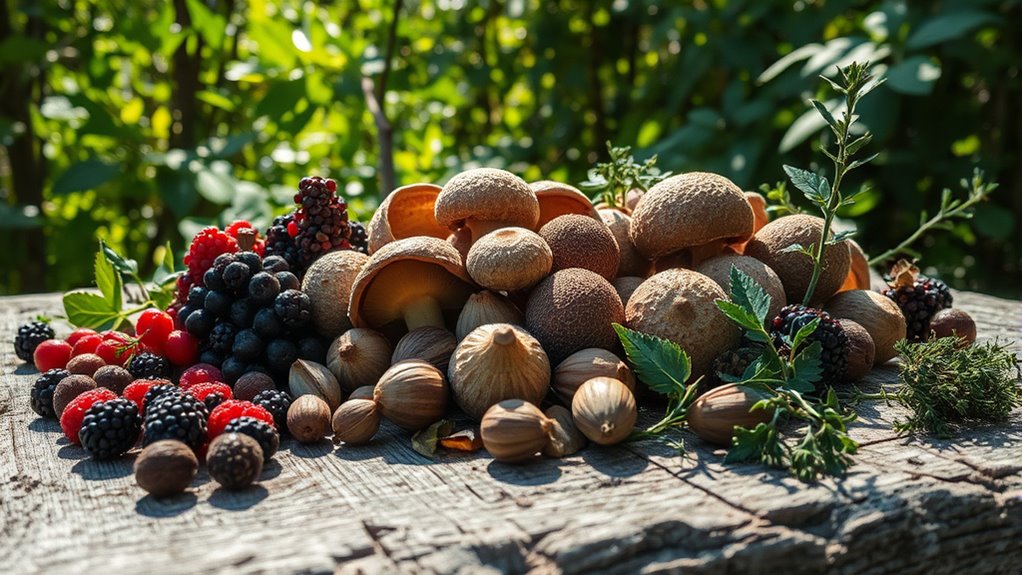
Practicing and testing your foraging skills before SHTF is essential to build confidence and guarantee you can reliably identify edible plants and resources in a real emergency. Start locally by exploring urban foraging to recognize safe plants and edible insects in your environment. Regularly practice identifying common edible species and differentiating them from look-alikes. Test your knowledge by foraging in controlled settings, noting seasonal changes and new finds. Use the table below to track your progress:
| Plant/Insect | Identification Tips | Edibility Status |
|---|---|---|
| Dandelion | Bright yellow flowers, jagged leaves | Edible, nutritious |
| Crickets | Hard shell, jumping legs | Edible, protein-rich |
| Wild berries | Bright color, seed pattern | Confirm before eating |
Consistent practice sharpens your skills and boosts confidence when SHTF.
Frequently Asked Questions
How Do I Identify Local Wildlife That Can Be Consumed Safely?
To identify local wildlife that’s safe to eat, focus on wildlife identification and edible species recognition. Study your region’s common edible animals, noting their physical features and behaviors. Use field guides, local expert advice, and observation skills to distinguish safe species from dangerous ones. Always confirm your findings with multiple sources, and avoid animals with signs of disease or unusual appearances. Practice responsible foraging to ensure safety and sustainability.
What Are the Legal Considerations for Foraging in Public Lands?
Think of legal considerations as a map you must follow carefully. You need to respect private property rights, avoiding trespassing, like staying on a marked trail. Check if you require permits or if there are regulations for foraging in public lands, since rules vary by location. Always research local laws before you go, because ignoring them could lead to fines or confiscation of your foraged items.
How Can I Discreetly Practice Foraging Without Alarming Others?
To discreetly practice foraging, you should use stealth techniques and concealment strategies. Move quietly, avoid sudden movements, and blend with your surroundings. Wear muted colors and carry minimal tools to prevent drawing attention. Stay aware of your environment, choose spots away from trails or crowds, and time your foraging during less busy hours. This approach guarantees you gather resources quietly without alarming others.
What Are the Best Methods to Signal for Help if Lost During Foraging?
Think of rescue signaling as your beacon in the storm, guiding help toward you. You should carry reliable signal devices like whistles, mirrors, or flares, which act as your voice in silence. Use rescue signaling techniques such as creating visible patterns with reflective objects or loud calls at regular intervals. These methods guarantee you’re seen and heard, turning your solitude into a clear message for rescue, no matter how lost you feel.
How Do I Handle and Prepare Wild Foods to Maximize Safety and Nutrition?
When handling wild foods, you should prioritize proper wild food preparation to guarantee safety and maximize nutritional preservation. Wash all edible plants thoroughly, remove any inedible parts, and cook foods like roots and meats to eliminate pathogens. Use gentle cooking methods to retain nutrients, and avoid consuming spoiled or questionable items. Proper handling reduces risks and preserves the food’s nutritional value, helping you stay nourished and safe during your wilderness adventure.
Conclusion
Don’t let the idea of building a forager’s cache overwhelm you. With some planning and practice, you can confidently gather wild foods and stay prepared for emergencies. Even if you’re new to foraging, start small and learn as you go—your skills will improve over time. Remember, the effort you put in now can provide essential sustenance when it’s needed most, ensuring you’re not caught unprepared.


